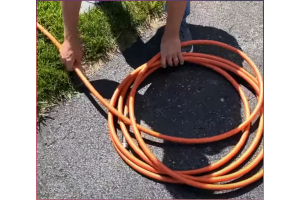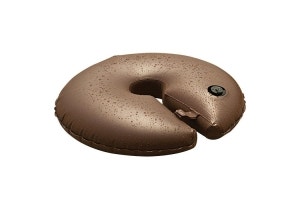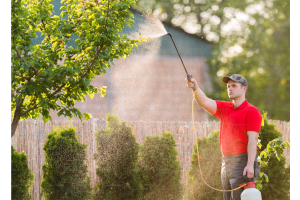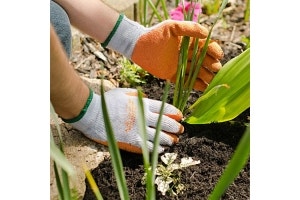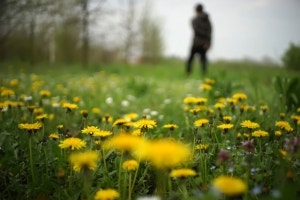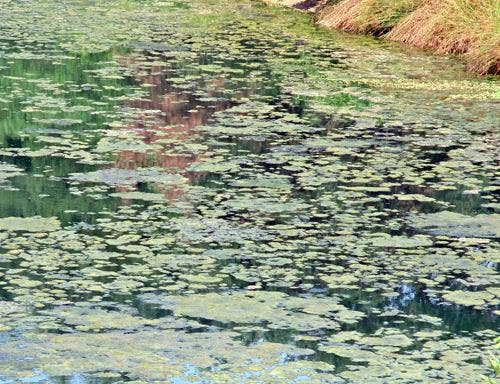
Know your pond scum! A.M. Leonard’s quick guide to achieving a beautiful, clean pond.
Pond owners often wonder why they must worry about what lurks at the bottom of the pond. This is especially true if the surface looks good. As it turns out, beauty is not just skin-deep. This especially true when it comes to pond maintenance!
What you see on the surface of the water is a direct result from what is happening below. As dying or decaying organics (dead algae, twigs, grass clippings, fish waste, leaves, etc.) enter your pond and accumulate at the bottom, they decompose and create pond muck. Pond muck is a black or brown, sticky, slimy substance that builds at the bottom of many ponds and lakes.
Just like compost is rich for gardens, muck contains high levels of nutrients and is an excellent food source for annoying algae and aquatic weeds that you do not want to see at the surface. If you do not take proper methods to stop and prevent muck, the muck layer increases, and so do your problems with these aquatic nuisances. As if that is not bad enough, muck is also a fertile breeding ground where leeches thrive.
Below is our guide to the most common algae and submersed weeds. Identifying the problem helps you choose the best solution and aids you in using the proper application rate. For more details, we recommend Texas A&M’s Agrilife AQUAPLANT diagnostics tool. We have also provided an easy-to-follow schedule for our 4-step program to remove muck, kill algae and aquatic weeds, and keep your pond sparkling.
Identifying Different Types of Algae
Green water, moss, hair-like algae, scum, pond scum, slime, algae mats… these are the usual names used to describe algae in ponds. While there are many different forms, the most common types of algae are easy to identify. They are:
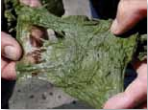
Filamentous Algae: Filamentous algae, also called hair-like algae, usually attaches itself to the bottom of the pond’s floor and to rocks. When especially bad, filamentous algae breaks free and floats on the surface in the form of thick algae mats.
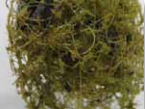
Chara: Chara grows on the bottom of the pond floor in large pillow formations. Chara is often mistaken for a weed although it lacks real roots and does not grow above the surface of the water. Chara has a musky odor and a crunchy texture.
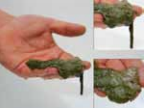
Oscillatoria: Talk about pond scum! Oscillatoria is a form of filamentous commonly referred to as black or blue-green algae. It can also give your pond a red-purple tint. These may colors you want in your sunset… but not in your water.
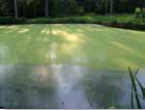
Planktonic, or Microscopic, Algae: Planktonic algae can change the color of your pond water to pea soup green, brown, or red. Early detection is virtually impossible. Because these are such small organisms, the only way to know your pond is infected is to visually see that your water has changed color.
Submersed Pond Weed Identification
Hundreds of types of submersed and floating weeds grow in ponds and lakes. This guide covers the most common.
Submersed weeds root at the bottom of the pond. Most of, if not all of, the plant stays underwater. Submersed weeds include coontail (hornwort), bladderwort, and curly leaf pond. It is best to control these plants with herbicides that contain diquat. Our experts recommend Tsunami.
Since they do not possess attached roots, floating weeds float on the surface of the pond or lake. The water regularly washes over the top of the plant when the pond’s surface is disturbed. Below, we have provided information with which you can identify both types of these weeds.
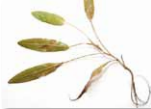
Large Leaf Pondweed: Large-leaf pondweeds have both floating and submersed leaves. Submersed leaves are large, oblong, wavy, and taper to the stem. Floating leaves are oval shaped. Parallel leaf veins are evident. Stems are seldom branched. Leaves alternate on the stem. Solid, tightly packed spikes at the tip of the weed rise above the water surface.
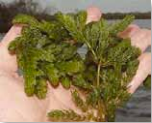
Coontail: The leaves of the Coontail whorl around the stem. They have a serrated appearance. Spacing between the leaf whorls is variable. Consequently, these weeds may be long and sparse or bushy. Near the end of the stem, the leaves and whorls are crowded. Branches fork repeatedly. Many people misidentify this weed as Chara.
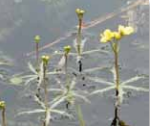
Bladderwort: Bladderwort has finely divided leaves scattered along the stem. The leaves possess numerous bladder-like structures. Stems have many branches and are densely leafy at the tips. Flowers are yellow and rise above the surface.
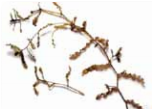
Curly Leaf Pondweed:Curly leaf pondweed leaves are thin with wavy and finely serrated edges. Its stems branched. Upper leaves are often crispy and appear waxy. Leaves alternate along the stem. Flowers borne on spikes rise above the water’s surface.
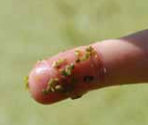
Duckweed: Duckweed leaves are the size of a pencil eraser. The leaves appear individually or, upon closer observation, in clusters. Small root hairs hang down from the underside of the leaf. No stem is distinguishable. Heavy growth blankets the surface with a depth of many inches. Duckweed does not interconnect like Filamentous Algae. People often confuse this weed with algae.
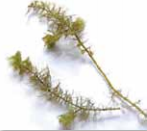
Water Milfoil: Water Milfoil leaves are whorled in groups of four. Each leaf divides into many thread-like leaflets extending from a central rib. This plant forms tangled mats at the surface. Seed heads develop in mid to late season and may extend above the water surface. Treat when weeds are actively growing, but do so before flowering occurs.
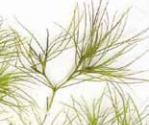
Naiad:Plants of Naiad guadalupensis are rooted, submersed, and range from 0.1 to 1.0 m long. The leaves are usually opposite or sub-opposite, and range from 0.2 to 2.0 mm wide, and 0.3 to 3.3 cm long. The teeth along the leaf margin are small. There are 18 to 100 teeth per side and they are barely visible to the naked eye. Sheaths at the base of the leaf round to a slightly auriculate (ear) shape. The flowers are small, inconspicuous, and borne in the leaf axils on the same plant.
AM Leonard’s 4-Step Pond Cleaning Program
Use the following 4-step program each month - as needed - per the label recommendations for the best performance and control.
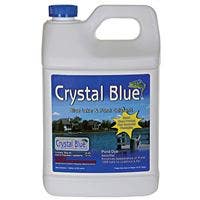
Step 1: Crystal Blue Lake & Pond Treatment
Enhance the color of your pond or lake all year long. Apply monthly from February to November.
Early Spring (February thru April): Colors and enhances the appearance of your pond or lake. 1 gallon per surface acre, 4-6 feet deep.
Late Spring (May thru June): Maintain color and beauty with Crystal Blue.
Summer (June thru August): Treat again with Crystal Blue as rain may have lowered the volume of color. Crystal Blue colorant also helps dilute floating material.
Early Fall (September thru December): Continue through fall with Crystal Blue for color enhancement.
Benefits of Crystal Blue Lake & Pond Treatment:
- Clears up muddy ponds
- 100% safe for humans, fish, livestock, pets, birds, swimming, potable water and irrigation
- Maintains color and clarity all year long
- Helps settle out dissolved solids
- 1 gallon treats 1 surface acre, 4-6 feet deep
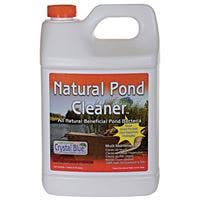
Step 2: Natural Pond Cleaner Muck Remover
Natural Pond Cleaner safely and effectively breaks down muck and dead vegetation. Use from February to November to treat ponds.
Early Spring (February thru April): Digests muck and other organic material. Clears out dead material from winter, including fish, debris, muck and sludge.
Late Spring (May thru June): Continue to increase the volume of healthy bacteria for the reduction of micronutrients.
Summer (June thru August): Nature Pond Cleaner is key during warm summer months as rain and fertilizer runoff invades pond. Dead algae will float to the bottom and become muck. Use Natural Pond Cleaner to safely remove this material.
Early Fall (September thru December): With Natural Pond Cleaner, healthy ponds have high levels of good bacteria counts, important for a healthy balance. Clean out dead vegetation and muck heading into winter.
Benefits of Natural Pond Cleaner Muck Remover:
- Safely breaks down muck and dead vegetation
- Supercharges naturally occurring bacteria to consume micronutrients for a healthy, clear pond.
- 100% safe for humans, fish, livestock, pets, birds, swimming, consumption and irrigation
- Helps settle out dissolved solids
- 1 gallon treats 1 surface acre, 4-6 feet deep
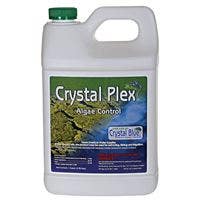
Step 3: Crystal Plex Aquatic Algaecide & Herbicide
Kills algae and maintains water quality. If algae currently exists, skip to step 3 to start. Apply from April to September for filamentous and planktonic algae control.
Early Spring (February thru April): Apply when temperatures are above 50 degrees F.
Late Spring (May thru June): When first algae blooms are noticed, use Crystal Plex.
Summer (June thru August): Shoreline algae possibly resurfaces. Generally safe for fish, livestock, and waterfowl when applied per label directions. However, some exceptions may apply; please read directions thoroughly.
Early Fall (September thru December): Later-season algae can still emerge; use as needed.
Benefits of Crystal Plex Aquatic Algaecide & Herbicide:
- Controls many types of algae, including filamentous, chara, and planktonic, for a beautiful and safe pond all year round
- Uses proprietary stabilizers
- Long-term algae control
- 100% safe for humans, livestock, pets, birds, swimming, consumption, and irrigation. Not for use in Koi or trout ponds
- Treat only a third to a half of your pond at a time
- 1 gallon treats 1 surface acre, 1-3 feet deep
- For one acre, mix 1 gallon of Crystal Plex with 10 gallons of water and spray directly on the algae mats
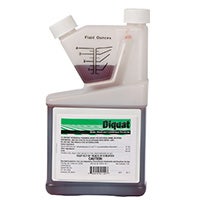
Step 4: Diquat Herbicide Water Weed and Landscape Herbicide
Agrisel's Diquat herbicide is a non-volatile herbicide for use to control weeds in aquatic areas. Absorption and herbicidal action is very rapid and effects are visible within 1-2 days. Key Product Benefits Provides excellent aquatic and non-crop weed control killing most submerged aquatic weeds. Low use rate makes Diquat economical to use.
- Active ingredient: Diquat Dibromide 37.3%
- 1 Quart Bottle
- Not For Sale In New York
Floating and Marginal Weeds Controlled
Submersed Weeds Controlled or Suppressed
See Label for use rates of Diquat in Aquatic environments.








